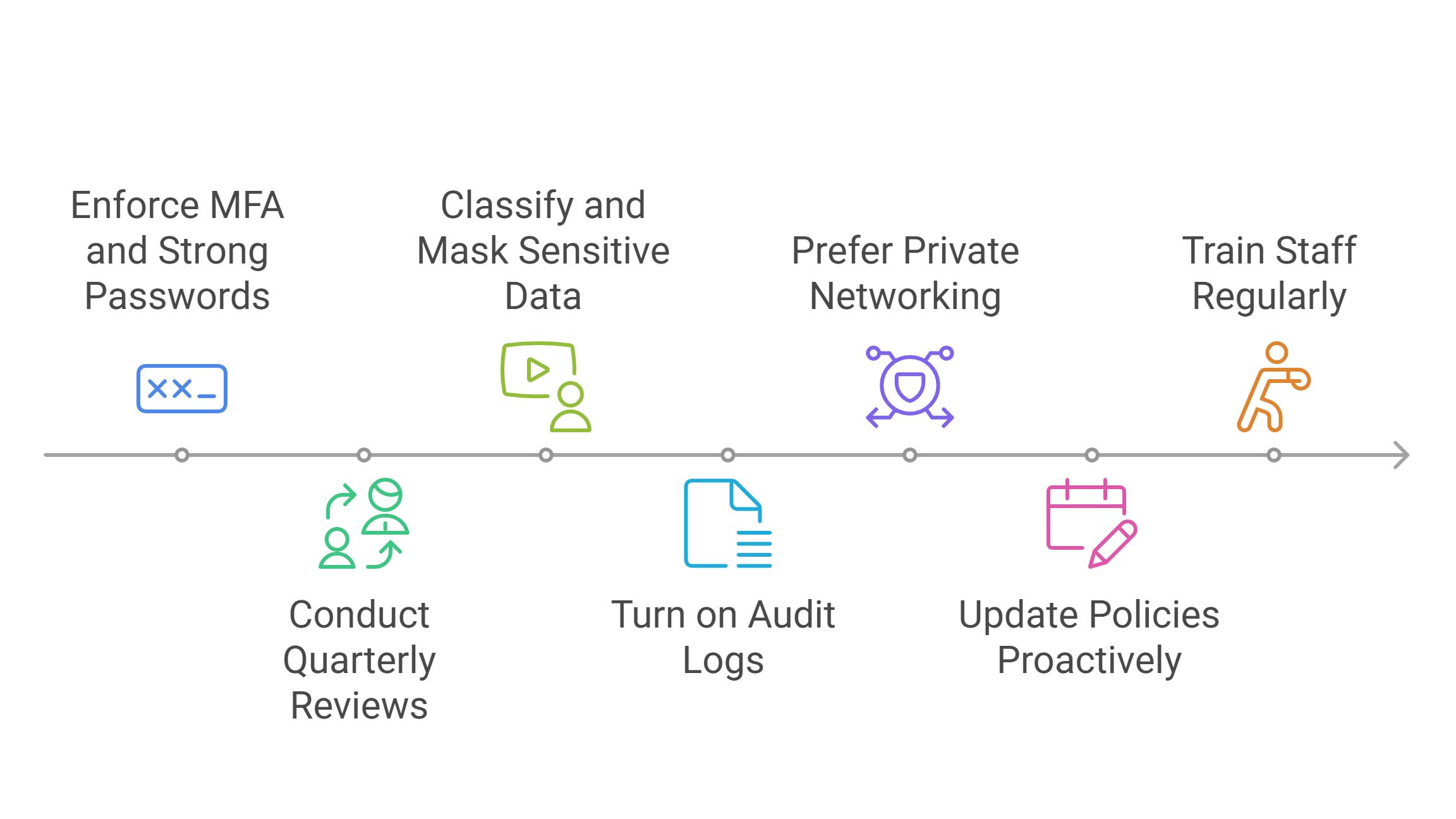
Snowflake Security Essentials The New Standard for Cloud Data Protection
The rise of cloud computing has transformed the way organizations use data, making agility and scalability more accessible than ever before. However, with this power comes a new generation of security risks and responsibilities. This is why understanding and implementing Snowflake Security Essentials is critical for organizations that want to succeed in a data-driven world.
As threats grow more complex and regulations more demanding, robust security becomes the only path to long-term business resilience. In this guide, you will learn everything you need to make Snowflake the safest cloud environment for your most sensitive data.
The Importance of Comprehensive Cloud Security
Why Cloud Security Cannot Be Overlooked
Transitioning to the cloud unlocks exponential business growth. Nevertheless, it also exposes organizations to new cyber risks. Attackers are more coordinated and sophisticated than ever, often targeting weaknesses in access controls or exploiting gaps in monitoring.
Moreover, clients and partners expect more than just baseline security—they demand evidence of best-practice protection and the ability to respond swiftly if something goes awry. Consequently, Snowflake’s security architecture addresses these modern challenges with a multi-layered, proactive approach.
The Cost of Inadequate Protection
It is crucial to recognize that a single misstep can result in data breaches, massive fines, and reputational harm that could take years to repair. For this reason, adopting Snowflake Security Essentials is not simply a technical decision, but a core business imperative.
Pillar 1: Identity and Access Management
Building a Strong First Line of Defense
One of the most important aspects of cloud security is knowing exactly who can access your data, and under what circumstances. Because identity is the primary perimeter in the cloud, Snowflake makes authentication and authorization its top priority.
Using Multi-Factor Authentication (MFA)
These days, relying on passwords alone is dangerous. Enabling MFA for all users introduces a second layer of verification, making it dramatically harder for attackers to compromise accounts—even if credentials are stolen. In addition, MFA discourages unauthorized access from internal actors by reducing the risks associated with weak or reused passwords.
Implementing Role-Based Access Control (RBAC)
Next, RBAC helps enforce the principle of least privilege. Assign every user a specific role that determines what data and tools they can access. As your organization evolves, update roles regularly to reflect changes in personnel or responsibilities. Consequently, you reduce the risk of accidental data disclosure and make auditing much more straightforward.
Centralizing with Single Sign-On (SSO)
Furthermore, integrating Snowflake with enterprise identity providers through SSO provides a seamless and secure login experience. This also allows your IT team to control access termination instantly if an employee leaves or moves to a different position, closing a common loophole for privilege creep.
Pillar 2: Data Encryption Everywhere
Keeping Data Safe in Transit and at Rest
Snowflake’s security strategy requires all data to be encrypted, whether it resides in storage or is being transmitted between users and the platform. This dual approach offers peace of mind, safeguarding your business against both external hacks and internal mishandling.
Encryption at Rest
When data is stored in Snowflake, it is automatically encrypted using industry-standard algorithms. Should a physical drive become compromised, the data remains unreadable to anyone lacking the proper keys.
Encryption in Transit
Equally important, data moving through networks to and from Snowflake receives strong end-to-end encryption. By using secure communication protocols, you ensure that even intercepted data remains inaccessible to cybercriminals.
Customer-Managed Keys for Increased Control
For companies with strict regulatory pressure or security preferences, Snowflake allows full customer control over encryption keys. By managing your own keys, your team gains complete authority over the encryption lifecycle and access permissions.
Pillar 3: Advanced Data Masking and Privacy Controls
Protecting Sensitive Information While Maximizing Utility
Merely locking down access is not enough. Today, data privacy regulations such as GDPR and HIPAA require organizations to ensure sensitive details remain protected—even from internal misuse.
Dynamic Data Masking
With dynamic data masking, Snowflake can hide or partially obscure columns containing confidential details unless the user has explicit permission. For instance, support agents can work with real customer records, but see masked credit card numbers, while finance teams with higher authorizations view the full data set.
Comprehensive Data Tagging and Classification
Another key advantage is the ability to classify and tag data at a granular level. By labeling information as personal, confidential, or regulated, you can automate policies that ensure data protection across all workflows. In addition, you streamline compliance reporting for demanding regulators.
Pillar 4: Network Security and Private Connectivity
Shielding Data from External Threats
Network security represents another vital line of defense. Rather than keep data open to the public internet, Snowflake advocates for:
Private Networking
Opt for dedicated, private cloud-to-cloud connections that exclude your data from public exposure. As a result, traffic stays within trusted boundaries, lowering the risk of interception.
IP Whitelisting and Firewall Rules
By limiting access solely to approved addresses and integrating with firewalls, your security perimeter becomes far less porous. Furthermore, real-time controls allow you to respond immediately to new threats by updating network policies.
Pillar 5: Monitoring, Auditing, and Anomaly Detection
Gaining Full Visibility and Staying Ahead of Threats
Continuous monitoring is non-negotiable in the face of today’s sophisticated threats. Snowflake continuously tracks system and user activity, providing a detailed record for audits and investigations.
Audit Logging and Forensic Trails
All actions—such as queries, permission changes, and data exports—are logged automatically. Should an unauthorized event occur, your team is equipped to track the issue, identify root causes, and report findings for compliance.
Automated Anomaly Detection
AI-driven systems look for unusual login patterns, strange data access times, or suspicious data downloads. Additionally, real-time alerts let you act before minor incidents escalate into serious breaches.
Pillar 6: Data Sharing with Built-In Security
Collaborating Without Compromise
Data sharing is fundamental for agile, modern organizations. Even so, secure collaboration is possible only when access is rigorously controlled.
Role-Based Sharing Controls
For example, you can share relevant data across teams or with external partners while keeping strict role-based restrictions. Thus, sensitive views remain private even as collaboration expands.
Secure Data Shares and No-Replication Collaboration
Because Snowflake supports data sharing without replication, you can stream real-time data to partners or subsidiaries without exporting copies or multiplying risk. This unique feature sets a new standard for security-conscious organizations.
Best Practices for Maximizing Your Security Posture
Easy Steps for Lasting Protection

- Enforce MFA and strong password policies for all users, without exceptions.
- Conduct quarterly reviews of user and role permissions, removing unnecessary privileges promptly.
- Classify and mask sensitive data columns as soon as new datasets are ingested.
- Turn on audit logs and monitor them for deviations from normal patterns.
- Prefer private networking and IP whitelisting for all critical workloads.
- Update policies proactively in response to new regulatory requirements or security discoveries.
- Train your staff regularly, emphasizing secure data handling and responsive action in case of a breach.
Industry Example: Securing Healthcare Data in the Cloud
Let’s consider a healthcare analytics provider migrating to Snowflake. Prior to migration, strict industry regulations demanded encrypted patient data, limited exposure of personally identifiable information, and detailed audit trails.
- The IT team implemented RBAC—granting only clinicians access to sensitive health records, while researchers accessed anonymized datasets.
- Dynamic data masking hid patient birthdates and addresses from non-clinical staff.
- Private networking and strict IP whitelisting ensured access was possible only from corporate premises.
- Continuous monitoring caught an attempted download of a large dataset outside business hours. Alerts triggered an investigation and rapid remediation.
Not only did the provider meet regulatory criteria, but it also built trust with clients and achieved greater agility in launching new services.
Conclusion: Secure Your Future with Snowflake’s Holistic Approach
In the digital era, thriving companies are those that treat data as both an asset and a responsibility. By implementing these Snowflake Security Essentials, you achieve more than compliance—you cultivate a culture of trust, agility, and resilience.
While threats will always evolve, your dedication to robust, layered security is the best guarantee of long-term business health. Now is the time to take action; invest in strong controls, empower your teams with knowledge, and keep your data safe—no matter what tomorrow brings.
Frequently Asked Questions
What is the first security feature to activate on Snowflake?
Multi-factor authentication is the first, most impactful step, as it blocks the majority of unauthorized access attempts.
How often do user roles and permissions need reviewing?
Quarterly reviews are recommended, with additional checks after any staff changes or organizational restructuring.
Can these security features support financial services compliance?
Yes, Snowflake Security Essentials map directly to major compliance frameworks, including PCI-DSS, SOC 2, and GDPR.
How does automated anomaly detection help?
By identifying strange patterns—like large exports or logins from unusual locations—Snowflake lets you act before an incident becomes a crisis.
Is Snowflake Security Essentials suitable for small companies?
Absolutely! Security scales with your organizational needs, so small and mid-sized businesses benefit from the same robust controls as large enterprises.

